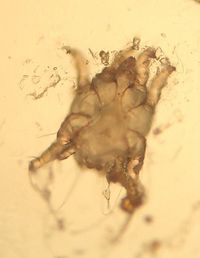Difference between revisions of "Otodectes cynotis"
Jump to navigation
Jump to search
| Line 3: | Line 3: | ||
[[File:Otodectes cynotis.jpg|thumb|200px|right|Otodectes cynotis (Courtesy of C. Antonczyk)]] | [[File:Otodectes cynotis.jpg|thumb|200px|right|Otodectes cynotis (Courtesy of C. Antonczyk)]] | ||
| − | Otodectes cynotis mites are [[Non-Burrowing Mites|surface mites]]. They are | + | Otodectes cynotis mites are [[Non-Burrowing Mites|surface mites]]. They are the cause of [[Otodectic Dermatosis|otodectic skin infestation]], the most common mange of dogs and cats in the world. They are also found in the fox and the ferret. The mites inhabit the inner ear and feed on ear debris. |
| − | + | ==Identification== | |
| − | + | The mites have closed keratinous bars ('''apodemes''') on their ventral surface. They are smaller in size than [[psoroptes cuniculi]] | |
| − | |||
| − | |||
| − | |||
| − | |||
*Life cycle takes '''3 weeks''' | *Life cycle takes '''3 weeks''' | ||
| − | |||
Revision as of 07:00, 11 July 2010
| This article is still under construction. |
Otodectes cynotis mites are surface mites. They are the cause of otodectic skin infestation, the most common mange of dogs and cats in the world. They are also found in the fox and the ferret. The mites inhabit the inner ear and feed on ear debris.
Identification
The mites have closed keratinous bars (apodemes) on their ventral surface. They are smaller in size than psoroptes cuniculi
- Life cycle takes 3 weeks
Pathogenesis
- The majority of cats harbour the mites, however only a few show symptoms
- Transmission occurs whilst kittens are suckling
- Common cause of otitis externa in dogs
- Brown waxy exudate produced
- Can lead to secondary infection
- Clinical signs are apparent
- Head shaking
- Ear scratching
- Aural haematomata
Treatment
- Acaracidal ear drops
- Massage base of ear to disperse drops after treatment
- Most treatments need to be repeated in 10-14 days to kill newly hatched mites
- Selamectin can be used as a spot-on treatment
- Prolonged duration of action
- Treat all in-contact animals
- These may be asymptomatic carriers
